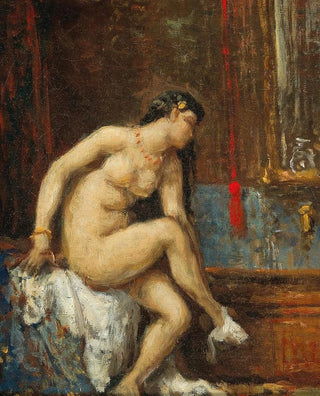Art print | At her toilette - Théodore Chassériau


View from behind

Frame (optional)
Art print of Theodore Chassériau’s "À sa toilette" – Captivating introduction
In the fascinating universe of art history, certain works transcend time and continue to evoke deep emotions within us. "À sa toilette" by Théodore Chassériau is one of these iconic creations. This painting, a true ode to beauty and femininity, immerses us in an intimate moment, a scene from everyday life where grace and delicacy meet. Offering us a glimpse into the inner world of a woman during her ritual preparation, Chassériau invites us to share a suspended moment, where the gaze is lost in refined details and subtle nuances of light. This piece, both intimate and universal, reminds us of the importance of art in our quest to understand the human condition.
Style and uniqueness of the work
Chassériau's style is distinguished by its harmonious blend of classicism and romanticism. In "À sa toilette," the finesse of the lines and the richness of the colors demonstrate remarkable technical mastery. The artist skillfully plays with shadows and light, creating a soft and soothing atmosphere. The composition is carefully orchestrated, with each element thoughtfully placed to enhance the harmony of the scene. The depicted woman, both vulnerable and majestic, embodies timeless beauty that transcends eras. The details of her toilette, from delicate drapes to carefully chosen accessories, add an extra dimension to the work, inviting the viewer to immerse themselves in this universe of refinement. Chassériau thus manages to capture the very essence of femininity, while evoking a sensitivity that resonates deeply with our own experience.
The artist and his influence
Théodore Chassériau, born in 1819, is often regarded as one of the precursors of the Impressionist movement, although his work is rooted in Romanticism. A student of the illustrious painter Ingres, he developed a style that is uniquely his own, incorporating elements of Orientalism and Neo-Classicism. His influence extends to many artists who followed him, notably through his ability to explore the psychology of characters and to

Matte finish

View from behind

Frame (optional)
Art print of Theodore Chassériau’s "À sa toilette" – Captivating introduction
In the fascinating universe of art history, certain works transcend time and continue to evoke deep emotions within us. "À sa toilette" by Théodore Chassériau is one of these iconic creations. This painting, a true ode to beauty and femininity, immerses us in an intimate moment, a scene from everyday life where grace and delicacy meet. Offering us a glimpse into the inner world of a woman during her ritual preparation, Chassériau invites us to share a suspended moment, where the gaze is lost in refined details and subtle nuances of light. This piece, both intimate and universal, reminds us of the importance of art in our quest to understand the human condition.
Style and uniqueness of the work
Chassériau's style is distinguished by its harmonious blend of classicism and romanticism. In "À sa toilette," the finesse of the lines and the richness of the colors demonstrate remarkable technical mastery. The artist skillfully plays with shadows and light, creating a soft and soothing atmosphere. The composition is carefully orchestrated, with each element thoughtfully placed to enhance the harmony of the scene. The depicted woman, both vulnerable and majestic, embodies timeless beauty that transcends eras. The details of her toilette, from delicate drapes to carefully chosen accessories, add an extra dimension to the work, inviting the viewer to immerse themselves in this universe of refinement. Chassériau thus manages to capture the very essence of femininity, while evoking a sensitivity that resonates deeply with our own experience.
The artist and his influence
Théodore Chassériau, born in 1819, is often regarded as one of the precursors of the Impressionist movement, although his work is rooted in Romanticism. A student of the illustrious painter Ingres, he developed a style that is uniquely his own, incorporating elements of Orientalism and Neo-Classicism. His influence extends to many artists who followed him, notably through his ability to explore the psychology of characters and to






